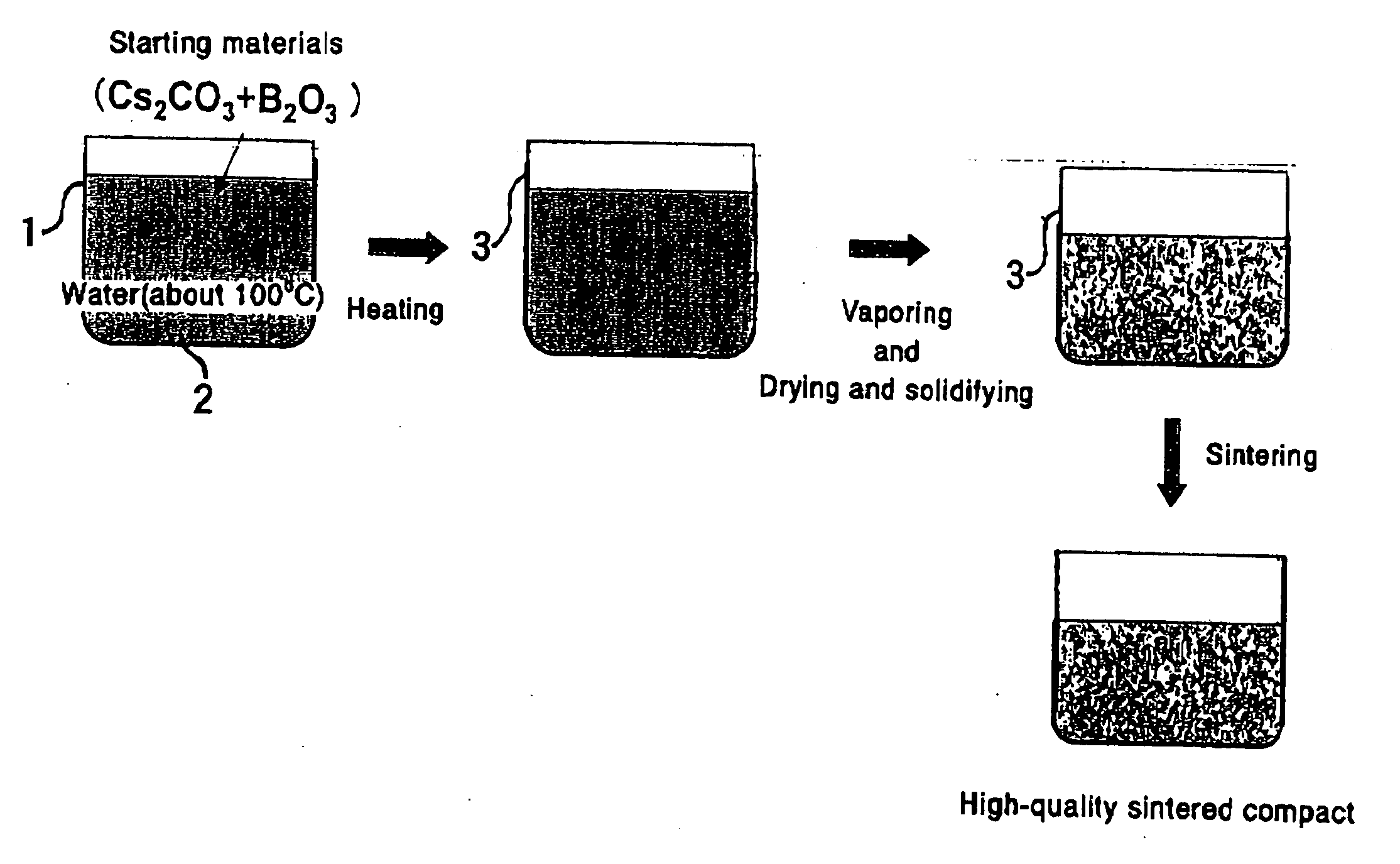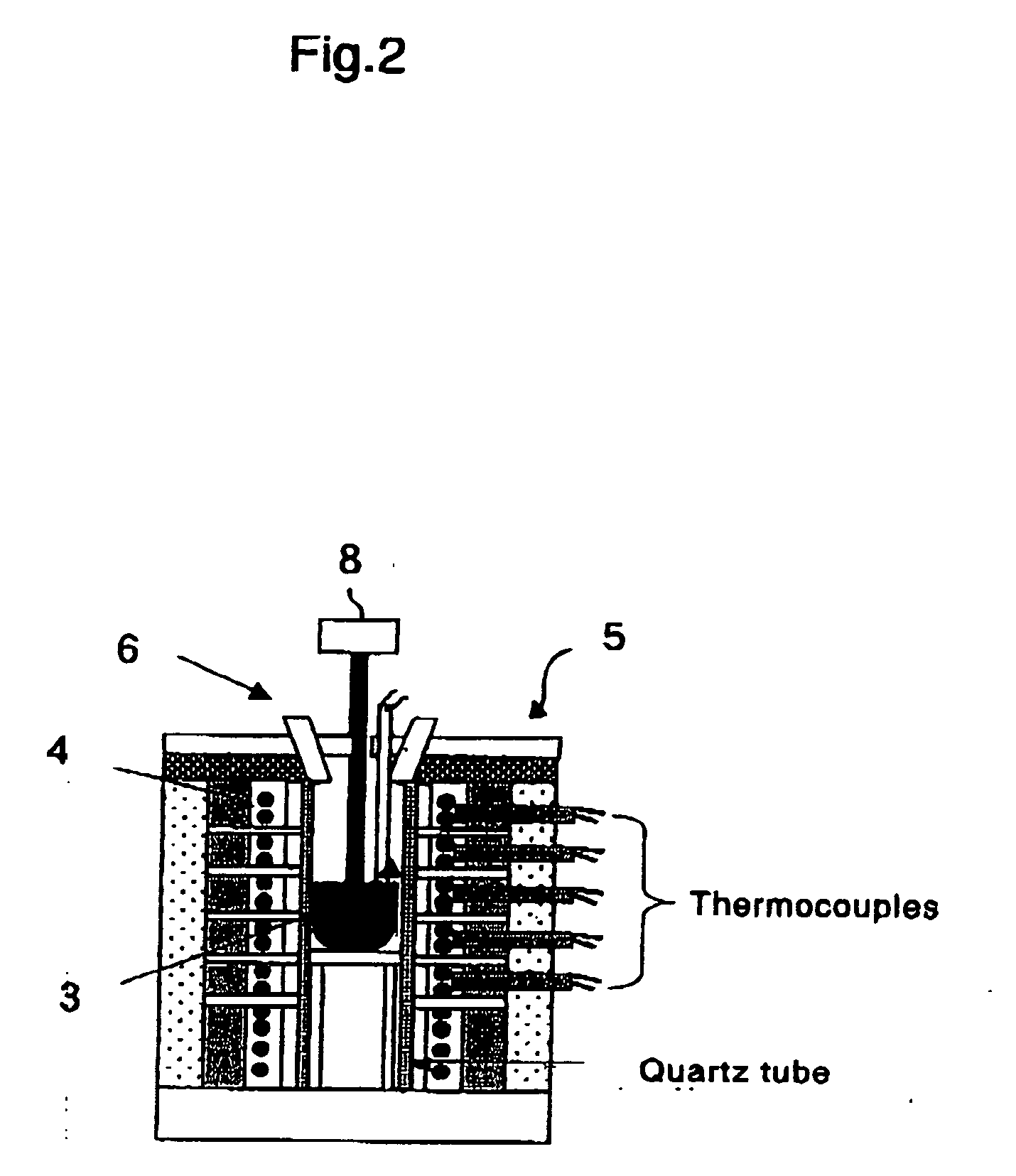Method for preparing borate-based crystal and laser oscillation apparatus
- Summary
- Abstract
- Description
- Claims
- Application Information
AI Technical Summary
Benefits of technology
Problems solved by technology
Method used
Image
Examples
example 1
[0072] A cesium-borate-based crystal was produced according to an embodiment of the method for producing a borate-based crystal of the invention.
[0073] First as shown in FIGS. 1(a) to 1(d), ion exchange water (2) was put in a polymethylpentene vessel (1) having a diameter of 20 cm and a height of 26 cm and heated to about 100° C. by a melting furnace, a uniform mixture of 4337.4 g of Cs2CO3 and 2162.6 g of B2O3 was added thereto and dissolved, and the water was evaporated by continued heating. Then, after evaporating the water, the residual material was charged in an open platinum crucible (3) having a diameter of 15 cm and a height of 15 cm, dried and solidified by heating at 300° C., and burned at 650° C. to obtain a crystal growth material. The crucible (3) was put in a five-layer-control cylindrical resistance heating furnace (5) for crystal growth haying heaters (4) shown in FIG. 2, and the upper opening of the cylindrical resistance heating furnace (5) was sealed by a heat in...
example 2
[0076] A cesium-borate-based crystal was produced under conditions different from those of Example 1 according to the method of the invention, and the cesium-borate-based crystal was used as a nonlinear optical crystal and evaluated with respect to the properties.
[0077] As shown in FIG. 1, ion exchange water (2) was put in a polymethylpentene vessel (1) having a diameter of 20 cm and a height of 26 cm and heated to about 100° C. by a melting furnace, a uniform mixture of 4671.1 g of Cs2CO3 and 2328.9 g of B2O3 was added thereto and dissolved, and the water was evaporated by continuing the heating.
[0078] After evaporating the water, the residual material was charged in an open platinum crucible (3) having a diameter of 15 cm and a height of 15 cm, dried and solidified by heating at 300° C., and sintered at 650° C. As a result of subjecting thus obtained crystal growth material to an XRD measurement, hardly anything but the peaks of CBO crystal are observed as shown in FIG. 4(b). FI...
example 3
[0084] In a conventional CLBO crystal growth, because a large amount, 6 kg, of starting materials are used and swelling is caused due to decarboxylation in the heating step, Cs2CO3, Li2CO3, and B2O3 powders are charged in a platinum crucible without mixing and firing, and then heated to 900° C. and melted, to obtain a growth solution. In this case, it is likely that in the heating process, B2O3 having the lowest melting point among the starting materials is melted first, and CiCO3 and Li2CO3 melt into the B2O3. Thus, it is expected that, when nonuniformly mixed starting materials are melted, the high-viscosity boric add-based starting material does not readily diffuse, local regions with a high Cs or Li content are generated, and the composition and structure of CLBO required for the crystal growth are not easily formed.
[0085] Therefore, the inventors tried to form a CLBO crystal phase by firing the starting material. The starting materials were stoichiometrically weighed, mixed in...
PUM
 Login to View More
Login to View More Abstract
Description
Claims
Application Information
 Login to View More
Login to View More - R&D
- Intellectual Property
- Life Sciences
- Materials
- Tech Scout
- Unparalleled Data Quality
- Higher Quality Content
- 60% Fewer Hallucinations
Browse by: Latest US Patents, China's latest patents, Technical Efficacy Thesaurus, Application Domain, Technology Topic, Popular Technical Reports.
© 2025 PatSnap. All rights reserved.Legal|Privacy policy|Modern Slavery Act Transparency Statement|Sitemap|About US| Contact US: help@patsnap.com



